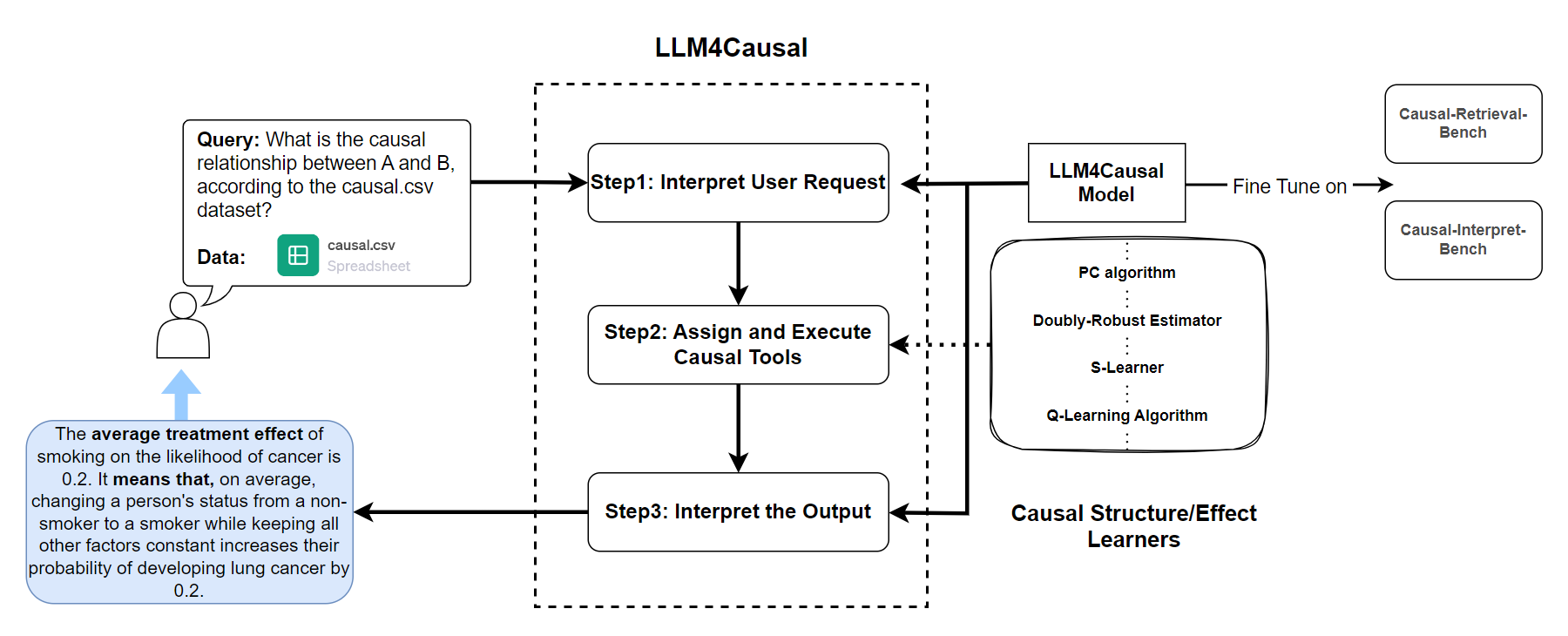Causal Inference with Large Language Model: A Survey

0

Sign in to get full access
Overview
- Provides a comprehensive survey of the use of large language models (LLMs) for causal inference
- Covers key topics such as causal reasoning, causal discovery, and causal decision-making in the context of LLMs
- Discusses the potential and limitations of LLMs in addressing causal inference challenges
Plain English Explanation
The paper explores how large language models (LLMs) can be used for causal inference - the process of understanding the underlying causes behind observed phenomena. Causal inference is a crucial task in many fields, from science to decision-making, and the rise of powerful LLMs has opened up new possibilities in this area.
The paper covers several key aspects of using LLMs for causal inference. It discusses how LLMs can be leveraged for causal reasoning, allowing them to understand and reason about the underlying causes behind textual data. It also explores the potential of LLMs for causal discovery, where the models can help uncover hidden causal relationships in complex datasets.
Additionally, the paper examines the use of LLMs in causal decision-making, where the models can be leveraged to make informed decisions based on an understanding of causal relationships. This has implications for a wide range of applications, from policy-making to personalized recommendations.
Overall, the paper highlights the significant potential of LLMs in the field of causal inference, while also discussing the challenges and limitations that researchers and practitioners need to address to fully harness the power of these models.
Technical Explanation
The paper provides a comprehensive survey of the use of large language models (LLMs) for causal inference, which is the process of understanding the underlying causes behind observed phenomena.
The authors first discuss the potential of LLMs in the field of causal reasoning, highlighting how these models can be leveraged to understand and reason about the causal relationships present in textual data. They explore various techniques, such as causal discovery and causal interventions, that can be used to uncover hidden causal structures within LLM-generated text.
The paper then examines the use of LLMs in causal decision-making, where the models can be used to make informed decisions based on an understanding of causal relationships. The authors discuss how LLMs can be applied to a range of applications, from policy-making to personalized recommendations.
Throughout the paper, the authors highlight the challenges and limitations of using LLMs for causal inference, such as the potential for biases and the need for robust evaluation metrics. They also discuss potential future research directions, such as the integration of causal reasoning with other AI techniques, and the development of specialized LLM architectures for causal inference tasks.
Critical Analysis
The paper provides a comprehensive and well-researched overview of the use of large language models (LLMs) for causal inference, highlighting both the potential and the limitations of these models in this domain.
One of the key strengths of the paper is its thorough coverage of the various aspects of causal inference, including causal reasoning, causal discovery, and causal decision-making. This breadth of coverage provides readers with a comprehensive understanding of the state of the art in this field.
However, the paper could have delved deeper into some of the specific challenges and limitations of using LLMs for causal inference. For example, the authors could have discussed the potential for biases in LLM-based causal reasoning, or the need for robust evaluation metrics to assess the performance of these models.
Additionally, while the paper touches on the potential applications of LLM-based causal inference, such as policy-making and personalized recommendations, it could have explored these use cases in more depth, highlighting the specific benefits and challenges associated with each.
Overall, the paper provides a solid foundation for understanding the role of LLMs in causal inference, and serves as a valuable resource for researchers and practitioners working in this field.
Conclusion
The paper presents a comprehensive survey of the use of large language models (LLMs) for causal inference, highlighting the significant potential of these models in areas such as causal reasoning, causal discovery, and causal decision-making.
The paper's thorough coverage of the various aspects of causal inference provides readers with a comprehensive understanding of the state of the art in this field. While the paper could have delved deeper into some of the specific challenges and limitations of using LLMs for causal inference, it nonetheless serves as a valuable resource for researchers and practitioners working in this area.
The potential implications of LLM-based causal inference are far-reaching, with applications ranging from policy-making to personalized recommendations. As the field of causal inference continues to evolve, the integration of powerful LLMs will undoubtedly play a crucial role in advancing our understanding of the underlying causes behind complex phenomena.
This summary was produced with help from an AI and may contain inaccuracies - check out the links to read the original source documents!
Related Papers


0
New!Causal Inference with Large Language Model: A Survey
Jing Ma
Causal inference has been a pivotal challenge across diverse domains such as medicine and economics, demanding a complicated integration of human knowledge, mathematical reasoning, and data mining capabilities. Recent advancements in natural language processing (NLP), particularly with the advent of large language models (LLMs), have introduced promising opportunities for traditional causal inference tasks. This paper reviews recent progress in applying LLMs to causal inference, encompassing various tasks spanning different levels of causation. We summarize the main causal problems and approaches, and present a comparison of their evaluation results in different causal scenarios. Furthermore, we discuss key findings and outline directions for future research, underscoring the potential implications of integrating LLMs in advancing causal inference methodologies.
Read more9/17/2024
💬

4
Causal Reasoning and Large Language Models: Opening a New Frontier for Causality
Emre K{i}c{i}man, Robert Ness, Amit Sharma, Chenhao Tan
The causal capabilities of large language models (LLMs) are a matter of significant debate, with critical implications for the use of LLMs in societally impactful domains such as medicine, science, law, and policy. We conduct a behavorial study of LLMs to benchmark their capability in generating causal arguments. Across a wide range of tasks, we find that LLMs can generate text corresponding to correct causal arguments with high probability, surpassing the best-performing existing methods. Algorithms based on GPT-3.5 and 4 outperform existing algorithms on a pairwise causal discovery task (97%, 13 points gain), counterfactual reasoning task (92%, 20 points gain) and event causality (86% accuracy in determining necessary and sufficient causes in vignettes). We perform robustness checks across tasks and show that the capabilities cannot be explained by dataset memorization alone, especially since LLMs generalize to novel datasets that were created after the training cutoff date. That said, LLMs exhibit unpredictable failure modes, and we discuss the kinds of errors that may be improved and what are the fundamental limits of LLM-based answers. Overall, by operating on the text metadata, LLMs bring capabilities so far understood to be restricted to humans, such as using collected knowledge to generate causal graphs or identifying background causal context from natural language. As a result, LLMs may be used by human domain experts to save effort in setting up a causal analysis, one of the biggest impediments to the widespread adoption of causal methods. Given that LLMs ignore the actual data, our results also point to a fruitful research direction of developing algorithms that combine LLMs with existing causal techniques. Code and datasets are available at https://github.com/py-why/pywhy-llm.
Read more8/21/2024


0
Large Language Models for Constrained-Based Causal Discovery
Kai-Hendrik Cohrs, Gherardo Varando, Emiliano Diaz, Vasileios Sitokonstantinou, Gustau Camps-Valls
Causality is essential for understanding complex systems, such as the economy, the brain, and the climate. Constructing causal graphs often relies on either data-driven or expert-driven approaches, both fraught with challenges. The former methods, like the celebrated PC algorithm, face issues with data requirements and assumptions of causal sufficiency, while the latter demand substantial time and domain knowledge. This work explores the capabilities of Large Language Models (LLMs) as an alternative to domain experts for causal graph generation. We frame conditional independence queries as prompts to LLMs and employ the PC algorithm with the answers. The performance of the LLM-based conditional independence oracle on systems with known causal graphs shows a high degree of variability. We improve the performance through a proposed statistical-inspired voting schema that allows some control over false-positive and false-negative rates. Inspecting the chain-of-thought argumentation, we find causal reasoning to justify its answer to a probabilistic query. We show evidence that knowledge-based CIT could eventually become a complementary tool for data-driven causal discovery.
Read more6/12/2024


0
Large Language Model for Causal Decision Making
Haitao Jiang, Lin Ge, Yuhe Gao, Jianian Wang, Rui Song
Large Language Models (LLMs) have shown their success in language understanding and reasoning on general topics. However, their capability to perform inference based on user-specified structured data and knowledge in corpus-rare concepts, such as causal decision-making is still limited. In this work, we explore the possibility of fine-tuning an open-sourced LLM into LLM4Causal, which can identify the causal task, execute a corresponding function, and interpret its numerical results based on users' queries and the provided dataset. Meanwhile, we propose a data generation process for more controllable GPT prompting and present two instruction-tuning datasets: (1) Causal-Retrieval-Bench for causal problem identification and input parameter extraction for causal function calling and (2) Causal-Interpret-Bench for in-context causal interpretation. By conducting end-to-end evaluations and two ablation studies, we showed that LLM4Causal can deliver end-to-end solutions for causal problems and provide easy-to-understand answers, which significantly outperforms the baselines.
Read more4/15/2024